My Triton Testing Results: By Randy Holmes-Farley
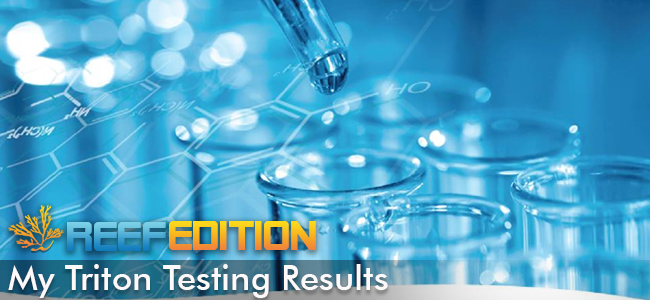
There are many different ions in seawater, and as reef aquarists we generally only test for a small number of these. Calcium, magnesium, “alkalinity”, nitrate, phosphate, and ammonia, for example, are relatively easy for hobbyists to test at home using kits. Other ions, however, are more difficult to evaluate because they are present at such low concentrations or are otherwise difficult to detect. Even if there was a suitable kit for every ion in seawater, buying several dozen kits would rapidly become cost prohibitive. There have long been commercial testing services that can analyze for most ions in seawater, but such services are often quite expensive, with a single test for a single ion costing as much or more than entire test kits.
Recently, Triton GmbH in Germany has initiated a method of testing many ions at once for a single price. In the US, that service is coordinated by Unique Corals. For $49 they will send you a couple of tubes to collect a tank water sample, and a prepaid mailer to send the sample back to them. They send it on for analysis, and the results are provided back to you.
This short article describes the results I obtained for my aquarium, and how I interpret them. Because I have not measured anything in my aquarium for years (except salinity and temperature), the results were of significant interest to me.
The method used is called ICP-AES (or ICP-OES), which stands for Inductively Coupled Plasma-Atomic Emission Spectroscopy (or -Optical Emission Spectroscopy). The liquid sample is sucked into a machine and heated to thousands of degrees, ripping apart all molecules in the sample to individual atoms and ions. As electrons on these ions fall back from excited energy levels to lower energy levels, specific wavelengths of light are emitted, and the machine can look for the wavelengths specific for each ion that the operator wants to detect and quantify: more light of that specific wavelength means more of those ions are present. Comparison of the aquarium sample to standard samples with known concentrations of ions in it allows quantitation of the ions present.
The reason that I am describing the analysis method is that it is important for interpreting the results in that it is essentially a way of counting atoms and ions in the sample. The method cannot determine anything about the nature of those atoms, except what they are. So, for example, a single result is obtained for something like iodine, even though there may be many forms that the iodine takes in the water sample, including iodide (I–), iodate (IO3–), iodine (I2), hypoiodate (IO–), hypoiodous acid (HOI), and many different organic forms, such as methyliodide (CH3I). All of these end up in the plasma as the same thing.
I am not, at present, able to make any comment on the accuracy of Triton’s testing. The method itself is capable of providing accurate results if done properly (I have used it myself in a variety of articles) and if the concentration of ions present rises above a certain threshold where the machine can adequately detect them. This threshold is sometimes called the limit of detection (LOD) or limit of quantitation (LOQ). While the LOD and LOQ are different, the difference wouldn’t interest most hobbyists. The important point is that the method cannot detect or quantify anything below what Triton refers to as its LOD. So think of that value as a lower limit if they report 0.00 as a value. As I write this, I have been told they are updating their data presentation to more clearly reflect that point, but my data do not show that improved clarity. At the moment, the LOD can be found on a document on their web site, but not on your individual data presentation. In short, for all of my comments that follow, I will assume that the Triton numbers are accurate within their limits of detection, but I do not know that to actually be the case.
I am also not at present able to review anything else about the Triton “method”, including their proposed “set points” which are the values they recommend, and their ways of boosting or reducing values that are not in line with their guidelines.
Unwanted Heavy Metals
The triton results are broken down into a variety of categories. I’ll present them in the same order they show up on the data set from Triton. The first is “unwanted” heavy metals. Some of these are not entirely unwanted, so the name can be a bit misleading. Copper, for example, is needed at natural levels (approximately 0.4 µg/L but varies with depth) but may be “unwanted” at substantially higher levels where it can be toxic. The table below shows the results for my aquarium. Note that 1 µg/L is approximately 1 ppb.
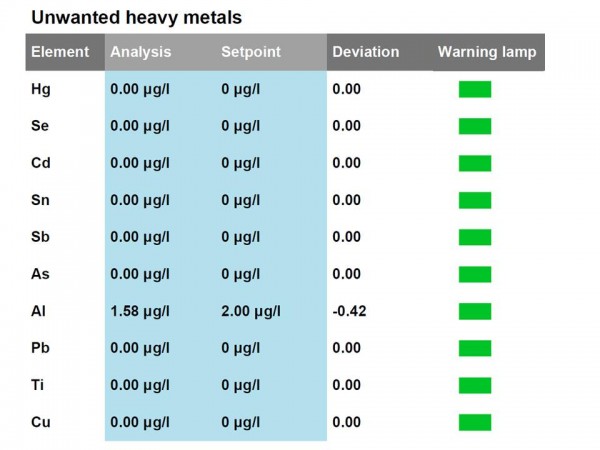
None of the heavy metals were detected at levels to indicate a concern. A number of years ago, I measured higher levels of copper (Cu) in my aquarium (about 13 µg/L). The Triton test shows none, with an LOD of about 1.2 µg/L. My husbandry practices are a bit different now, including now using GFO (granular ferric oxide) phosphate binder, organic carbon dosing (vinegar) and feeding some different foods, so that might explain the copper change. The fact that it was determined by different people on different machines, however, may also play a role. When I tested it myself, I was barely able to detect it above the background noise.
Macro-Elements
The next section of data from Triton is what they call Macro-Elements. These are basically the high concentration ions of seawater, although they do not give data for chlorine/chloride and the sulfate (SO4—) data is presented as just the sulfur part of the sulfate ion. My data set is shown below.
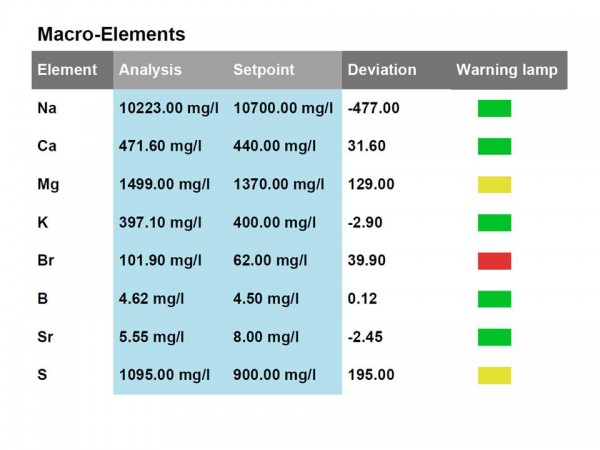 Salinity. If I look at the major cations (sodium (Na), calcium (Ca), magnesium (Mg), and potassium (K)), I can see that the total of these adds up to about what I’d expect for my water at what I know the salinity to be of about 35 ppt (specific gravity of about 1.0264). In normal seawater at salinity of 35 ppt, these would add up to about 12,900 mg/L. In my Triton test they added up to about 12,600 mg/L.
Salinity. If I look at the major cations (sodium (Na), calcium (Ca), magnesium (Mg), and potassium (K)), I can see that the total of these adds up to about what I’d expect for my water at what I know the salinity to be of about 35 ppt (specific gravity of about 1.0264). In normal seawater at salinity of 35 ppt, these would add up to about 12,900 mg/L. In my Triton test they added up to about 12,600 mg/L.
Looking at the individual ions, I see several things of interest:
Calcium (Ca). In my reef aquarium, I use only Instant Ocean salt and I have not added any additional calcium except as limewater for a number of years (during which time I have continued regular 1% daily water changes). So why is my calcium level (472 mg/L) higher than one would normally expect for Instant Ocean (maybe between 350 and 400 mg/L)? That long term rise in calcium is actually the expected result when using limewater to maintain alkalinity.
Limewater adds calcium and alkalinity in exactly the same proportions as in pure calcium carbonate. So if that is what is used by corals to make skeletons, and what precipitates on pumps and such, then calcium would stay constant.
But both magnesium and strontium get into growing calcium carbonate crystals in place of some of the calcium. A few percent of the calcium is replaced this way. Consequently, since the same amount of alkalinity (the carbonate) is used over time, and somewhat less than the balancing amount of calcium, calcium rises if alkalinity is maintained. I’m happy to see the result match the theory, and the calcium level seems fine to me.
Magnesium (Mg). Although I do not add magnesium to the aquarium, I have been adding it to the salt mix. In the past, Instant Ocean was on the low side in magnesium, and I determined that adding about 150 ppm (mg/L) of magnesium to it would get the aquarium water about where I wanted it. However, several years ago, the makers of IO boosted the magnesium in it. I didn’t bother to decrease the additions I was making to the new salt mix. It appears I should have stopped, as the magnesium in the tank was higher than I prefer (1500 mg/L). If I stop these additions, it will likely drop significantly, probably by about 150 ppm to 1350 ppm, and that’s a fine target for my aquarium. So, my main action item from this set of results is to stop adding extra magnesium to the salt (obviously, ordinary magnesium testing with a kit could also have determined this result).
Potassium (K). Many people are worried about potassium in their aquaria. About 4 ½ years ago, not long after I started using organic carbon dosing, I decided I should test to see if potassium was depleted in my aquarium. I compared my tank water to a true natural seawater sample and found about the same level in the standard as in my aquarium using a commercial test kit. The Triton result confirms that earlier conclusion: my aquarium is not becoming depleted in potassium despite skimming, growing macroalgae, and organic carbon dosing. Presumably, the foods and water changes are adequate to maintain the potassium level.
Bromine (Br; bromide). The bromide is elevated. I’m not sure why, but it doesn’t really worry me. It might be from the salt mix, or from foods. Except when using ozone, bromide is not a toxin to worry too much about. When exposed to ozone, it becomes bromate, which is more toxic, but that is really a concern for how to use ozone and the concern isn’t changed much by having bromide at 2x the natural level.
Boron (B; borate). The borate is about normal. I do not add it. It seemingly is not depleted in my aquarium.
Strontium (Sr). The strontium is slightly depleted, which is not surprising. I do not intentionally add any, except what small amounts come in with the limewater, and when calcium carbonate is deposited, some of the calcium ions are substituted by strontium, bringing it down over time. I do not presently think that strontium is a necessary or useful additive for most reef creatures, so I won’t take any action based on this result.
Sulfur (S; sulfate). The sulfate is a bit elevated over normal levels. Probably this indicates an imbalance in the chloride to sulfate ratio (more sulfate and less chloride than normal). It cannot simply be elevated sulfate because the salinity and the total cations mentioned above would not balance out. That extra sulfate might be from the salt mix or possibly from the Epsom salt I sometimes use to add magnesium to the salt mix (I also use magnesium chloride, and do so much more frequently than Epsom salt, but perhaps not as much as I should have). I’m stopping the magnesium additions, but if it is the salt mix, there’s nothing I can do except change mix (which I don’t plan to do at the moment). The limewater adds no sulfate or chloride, and I’d expect that what comes with foods would be overpowered by my water changes, but that assumption might be incorrect.
Lithium Group
The next section of Triton data is called the Lithium group for reasons that elude me. Maybe it is a data set that their machine collects together, but chemically they have no relationship that I can decipher.
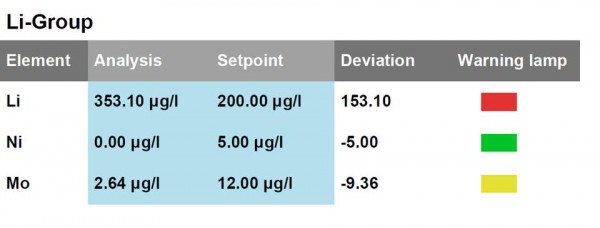
Lithium (Li). The lithium is elevated, and that is probably from the salt mix. A great many people have elevated lithium, and I’ve seen some fresh artificial salt water samples that also had it. It is probably an impurity in one of the main ingredients of a salt mix, but it can also come from calcium and alkalinity additives, such as calcium chloride. At this level it does not concern me. It’s biological properties (such as a medication in people) seem to happen at much higher levels, and in many ways it is chemically similar to sodium that is present at 30,000 times higher concentration.
Nickel (Ni). I would have lumped it with unwanted heavy metals. None detected.
Molybdenum (Mo). Molybdenum is low, and if that is true, it’s an interesting and potentially important result. I don’t typically add any trace elements. I may consider adding some molybdenum as it is biologically important.
I-Group
Triton calls the next section the I-Group.
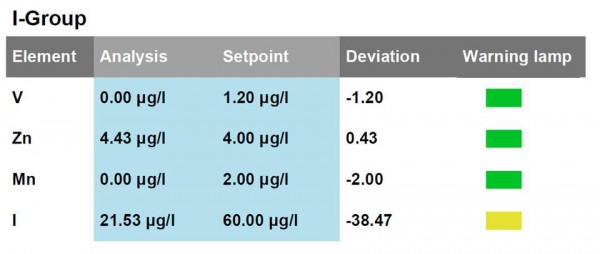
Curiously, I would interpret these values differently than Triton’s warning lamp.
Vanadium (V). Triton can just barely detect the natural level of vanadium (1.8 µg/L) since their LOD is 0.9 µg/L. Still, detecting none suggests it may be depleted, and is another possibility for dosing.
Zinc (Zn). The zinc is about spot on, so there’s not much to say about it.
Manganese (Mn). Triton can just barely detect the natural level of manganese (0.17 µg/L) since their LOD is 0.12 µg/L. Detecting none suggests it may be depleted, and is another possibility for dosing, but I have less confidence that this one is really seriously depleted since it is so close to the LOD. But Mn is biologically important and I will consider it.
Iodine (I). I don’t generally think that dosing iodine is useful for me based on my experience in dosing it for years, then stopping and seeing no difference. Many people have had that same experience. I also know that iodide and iodate deplete in my aquarium based on kit testing I’ve done in the past. So it does not surprise me that it is depleted since I do not supplement. Triton also detects organic forms of iodine, so when some folks (maybe especially those not doing water changes or skimming) get very highly elevated levels of iodine, it may be organic forms they are detecting. That is an interesting area to pursue since this sort of test is the only way to do studies on organic iodine levels.
Fe-Group
Triton calls this next section the Fe-Group.
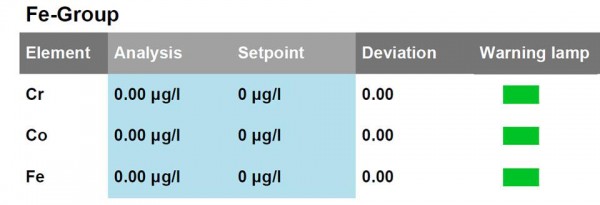
Triton cannot detect down to the natural seawater levels for any of these.
Iron (Fe). The natural iron level varies a lot with depth, but surface seawater may have only 0.006 µg/L. The Triton LOD = 0.3 µg/L. I dose iron, and when I dose it I boost iron to roughly 1-2 µg/L, which would be detectable. This sample was taken more than a week after the last iron dosing, and none was detected as it gets depleted in the meanwhile. I’ve not yet seen a Triton test result for a real aquarium sample that had detectable iron, but that doesn’t mean these tanks are necessarily deficient. Iron is also a case where the form is critical, and ICP cannot distinguish form. Binding to organic matter, for example, can alter the bioavailability of iron.
Chromium (Cr). Chromium is present in natural seawater at roughly 0.3 µg/L. The Triton LOD = 0.9 µg/L), so having none detected may be fine. We cannot really tell much, unless there is a substantial excess.
Cobalt (Co). Cobalt is present in natural seawater at roughly 0.006 µg/L. The Triton LOD = 0.4 µg/L), so having none detected may be fine. We cannot really tell much, unless there is a substantial excess.
Ba-Group

This group consists of barium (Ba) and beryllium (Be). Neither has biological utility, so there’s no need to have them and I’m happy that they are not unusually elevated.
Silicate and Nutrient Groups
The next two groups are nutrients.


Silicon (Si). I dose silicate (as sodium silicate solution) to my aquarium. I boost the concentration to about 200 µg/L of silicon equivalent once a week or so. This water sample was drawn one week after the last dose of silicate. I know from previous studies that silicate is rapidly depleted in my tank, presumably by sponges (the reason I dose it), by diatoms, and possibly by the GFO that I use to bind phosphate.
Phosphorus (P). In interpreting these numbers, the two values are just a mathematical conversion provided for convenience since many aquarists think in terms of ppm (mg/L) phosphate, rather than in µg/L phosphorus. But it is one analysis of all total forms of phosphorus, including organic and inorganic forms.
My aquarium is by no means a low nutrient system. However, I do use several active means to reduce nutrients, including vinegar dosing, GFO (granular ferric oxide), skimming and growing macroalgae (Caulerpa racemosa). This sample was taken one week after replacing the GFO and granular activated carbon I use. I usually wait to replace the GFO for another 2-3 weeks. Together, these methods seem to be keeping phosphate about where I want it.
Summary
What did I learn from this testing? Probably more than most people would since I rarely test even calcium. My lessons are:
1. I’m putting too much magnesium in my salt mix. I’m going to stop that.
2. Calcium is higher than my salt mix, as I had expected it would be.
3. There are some trace elements that I might usefully dose. I’ve occasionally dosed trace elements in the past (with no obvious benefit or detriment), but without being able to know what was depleted and what was already elevated, trace element cocktails didn’t hold much promise for me. Now that I know of some specific possibilities to dose (such as molybdenum or vanadium), I can look for appropriate ways to dose those and not the others. Still, I hadn’t planned on repeated Triton tests, so any trace element dosing will be complicated. I know how much to dose to attain natural levels, but not how long that would remain in the water.
4. The methods that I am using to export phosphate seem about right.
5. The amount of silicate and iron that I am dosing does not appear to be excessive.
6. I don’t have any apparent heavy metal issues to worry about.
7. My chloride to sulfate ratio may be skewed to too much sulfate.
8. I do not need to worry about supplementing potassium.
Overall, that seems quite a lot of information for a $49 test that took me less than 10 minutes of effort.
Please visit me in my Chemistry Forum at Reef2Reef if you have any questions!
Happy Reefing.
Comments are closed.
